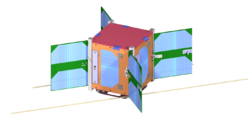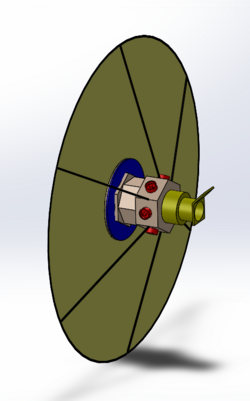Engineering:WARR (TUM)
The Scientific Workgroup for Rocketry and Spaceflight (WARR) (German: Wissenschaftliche Arbeitsgemeinschaft für Raketentechnik und Raumfahrt) is a scientific workgroup situated at Technical University of Munich, composed mainly of its students. It was founded by students in 1962 with the goal to compensate for the lack of a chair for space technology at the university at the time.[1] Since the establishment of such a chair in 1966, the group has conducted practical projects, starting with the first successful development and of a hybrid rocket in Germany. One rocket of this type was launched in 1972, another is on permanent display at Deutsches Museum. WARR has attained some public attention by for its projects in space elevator competitions,[2][3] small satellites[4] interstellar spaceflight concepts,[5] and for winning all SpaceX Hyperloop pod competitions.[6][7][8]
Currently, WARR works in the fields of hybrid propulsion, satellite technology, robotics, and transportation technologies.
History
| 1962 | Founding of WARR by Robert Schmucker (de)[citation needed] | |
| 1966–1974 | Research on engines for hybrid rockets[citation needed] | |
| 1974 | First flight of Barbarella (first German hybrid rocket, displayed in German Museum)[citation needed] | |
| since 1975 | Research on engines for liquid-propellant rockets | |
| 2000 | Construction of a hybrid demonstrator engine[citation needed] | |
| 2002 | Occupation of the new space in Garching and establishing a dynamometer | |
| 2004 | Presentation of projects at ILA in Berlin, Germany | |
| since 2005 | Scientific payload T-Rex on the Swedish sounding rocket Rexus in cooperation with the chair for space travel and the EADS Astrium GmbH. | |
| Work on the following projects: space elevator, cubesat (mini satellite) and Micro-Hybrid (miniature hybrid engine)[citation needed] | ||
| 2006 | First WARR Winter Launch (WWL, model rocket contest) and presentation of the project at the ILA in Berlin, Germany[citation needed] | |
| 2009 | Founding of WARR Interstellar Flight Team [9] | |
| 2011 | Organization and participation in the first European Space Elevator Challenge (EUSPEC) on the grounds of TU Munich[10] | |
| 2012 | Contribution to IdeenPark in Essen, Germany [11] | |
| 2012 | Participation in SpaceUp conference in Stuttgart, Germany[12] | |
| 2012 | Founding of a project group for satellite technology, and the initiation of work on Cubesat MOVE-II financed by German Aerospace Center[13] | |
| 2013 | Founding of the project group STERN, aiming to break the student record for rocket altitude in Europe[14] | |
| 2013 | Founding of the project group "WARR Space Manufacturing" for research on 3D printing in microgravity[15] | |
| 2013 | Launch of the student satellite First-MOVE into a polar orbit[16] | |
| 2013 | The project group ‘’Interstellar Space Flight’’ wins the international Icarus Design Competition for unmanned interstellar space probes with fusion engines[citation needed] | |
| 2015 | Launch of the experimental rocket WARR-Ex2 from CLBI in Brazil[17] | |
| 2015 | The project group ’’Interstellar Space Flight’’ wins the international Dragonfly Design Competition for unmanned interstellar space probes with laser sail engines[18] | |
| 2015 | Founding of WARR Hyperloop and the development of a prototype for a Hyperloop capsule for the SpaceX Hyperloop pod competition[19] | |
| 2017 | Winner of the Hyperloop pod competition I with a top speed of 93 km/h | |
| 2017 | Winner of the Hyperloop pod competition II with a top speed of 323.5 km/h[6] | |
| 2018 | Winner of the Hyperloop pod competition III with a top speed of 457 km/h[7] | |
| 2019 | Winner of the Hyperloop pod competition IV with a top speed of 463.5 km/h[8] |
Project groups of WARR
Rocketry
Existing since the foundation of WARR in 1962, the department for rocketry is the oldest project group of WARR. With the launch of the first German hybrid rocket in 1974, WARR achieved its first major success, which was promptly followed by the construction of multiple test engines. In 2009 the development of its next rocket began, called WARR-Ex2, powered by the in-house developed hybrid engine HYPER-1 with solid HTPB fuel and nitrous oxide as oxidizer. The rocket was successfully launched on 20 May 2015 from the missile base CLBI on the Atlantic coast of Brazil and reached a maximal altitude of approximately 5 km.[17] Even before the launch of WARR-Ex2, WARR had begun working on its successor, WARR-Ex3, as part of project STERN[20] (STudentische Experimental-RaketeN) (German abbreviation for "student experimental rocketry"), organized and financed by the German Aerospace Center. As the given objectives of STERN were already reached within WARR-Ex2, it was decided to build a larger rocket, which should break the European altitude record for student rockets, counting 21.5 km for now. To reach this goal, the WARR-Ex 3 uses liquid oxygen instead of nitrous oxide, while maintaining the use of HTPB.[14]
Satellite Technology
Since the cubesat First-MOVE was primarily developed by doctoral candidates from the institute of astronautics at the TUM, the involvement of students was intensified during the development of its successor MOVE-II. To make use of WARR's existing infrastructure, a new project group was founded, where the members could work on all subsystems. In 2012, development of a mission profile was started. After approval by the German Aerospace Center in 2015, launch of the satellite is expected in 2017.[13]
MOVE-II is a 10x10x10 cm big satellite (1U-Cubesat). It consists of a bus on the one side, which is responsible for power supply, communication and attitude control. Its Mission is to educate Students and Test some prototype Solar Cells.[citation needed] MOVE-IIb is an almost exact copy of MOVE-II launched in 2019.[citation needed]
Space-Elevator
WARR Space-Elevator is developing climber robots since its founding in 2005, and also organizes corresponding competitions. The first climber was developed for the JSETEC2009 competition and reached the targeted 150 m in the shortest time.[21] In 2011 the European Space Elevator Challenge (EUSPEC) was established, which also focused on energy efficiency.[22] Following that year the competition was repeated with increased cable length of 50 m.[23]
Interstellar Flight
The WARR Interstellar Flight Team (ISF) is working on concepts for interstellar travel.[24] The goals of WARR ISF are:
- Research on manned and unmanned interstellar travel
- Utilization of methods from engineering sciences, especially interdisciplinary system engineering
- Publication of results on international conferences and journals
- Presentation of research findings to the public
In May 2013 the "Ghost Team" of WARR ISF participated in Project Icarus.[25] The name "Ghost" derives from the sudden appearance of the team in the competition and resulting in confusion of the other participants. WARR presented its concept at the British Interplanetary Society in October 2013 and was awarded for the best design among 4 international teams.[25]
In October 2014 begun development of a laser propelled interstellar probe for the Project Dragonfly Design Competition, held by the Initiative for Interstellar Studies (I4IS). The WARR team could prevail in this competition against international competitors, too.[25]
Hyperloop
In August 2015 the project group Hyperloop was founded to participate in the Hyperloop Pod Competition sponsored by SpaceX. In January 2016, WARR's was one of 30 international teams selected (from a pool of over 700 initially participating[26]) to build a functional prototype for the final phase of the competition in summer of 2016.[19]
(As of June 2016), the prototype developed by WARR was intended to feature an electrodynamic suspension system to levitate and an axial compressor to minimize aerodynamic drag from the residual air inside the tube.[27][need quotation to verify]
The WARR pod was the fastest in the January 2017 competition which was run on the SpaceX Hyperloop test track—or Hypertube—a mile-long, partial-vacuum, 1.83-meter (72.0 in)-diameter steel tube purpose-built in Hawthorne, California for the competition. In December 2018, WARR Hyperloop was rebranded to TUM Hyperloop. Since this time it is managed by a separate organisation, called NEXT. [28][29]
See also
- Delft Aerospace Rocket Engineering
- Space Concordia
External links
References
- ↑ Sudhof, Samuel; Lungu, Paul (17 July 2013). "Hybrid Engine Development, Education and Outreach at Munich's Scientific Workgroup for Rocketry and Space Flight (WARR)". Joint Propulsion Conference Proceedings 49. doi:10.2514/6.2013-4137. ISBN 978-1-62410-222-6. http://arc.aiaa.org/doi/abs/10.2514/6.2013-4137. Retrieved 27 January 2014.
- ↑ European Space Agency. "Die Europaeische Space Elevator Challenge geht in die zweite Runde". ESA. http://www.esa.int/ger/ESA_in_your_country/Germany/Die_Europaeische_Space_Elevator_Challenge_geht_in_die_zweite_Runde.
- ↑ Japan Space Elevator Association. "Results from Asia's first ever Space Elevator Competition". http://www.spaceelevatorblog.com/Images/2009JSETEC/2009-08-13-PressRelease_english.pdf.
- ↑ Wilkens, Andreas. "Zwei bayerische Uni-Satelliten im Weltall". Heise Verlag. http://www.heise.de/newsticker/meldung/Zwei-bayerische-Uni-Satelliten-im-Weltall-2051346.html.
- ↑ Swinney, Robert. "Project Icarus Workshop Winner Announced". Icarus Interstellar. http://www.icarusinterstellar.org/project-icarus-workshop-winner-announced-andreas-heins-ghost-future-plans/.
- ↑ 6.0 6.1 Boyle, Alan (27 August 2017). "Germany's WARR team wins SpaceX's Hyperloop II race with 201-mph pod run". GeekWire (US). https://www.geekwire.com/2017/germanys-warr-team-wins-spacexs-hyperloop-ii-race-201-mph-pod-run/.
- ↑ 7.0 7.1 "WARR Hyperloop pod hits 284 mph to win SpaceX competition". The Verge. 18 July 2018. https://www.theverge.com/2018/7/22/17601280/warr-hyperloop-pod-competition-spacex-elon-musk.
- ↑ 8.0 8.1 "Team TUM wins SpaceX Hyperloop Pod Competition with record 288 mph top speed" (in en-US). 22 July 2019. http://social.techcrunch.com/2019/07/21/team-tum-wins-spacex-hyperloop-pod-competition-with-record-288-mph-top-speed/.
- ↑ "WARR Interstellar Space Flight". WARR. http://www.warr.de/isf/team.
- ↑ "Projekte 2011". Klaus Höchstetter Stiftung. http://www.klaus-hoechstetter-stiftung.de/index.php?option=com_content&view=category&layout=blog&id=16&Itemid=36.
- ↑ Pascal Hesse (2012-08-14). "Mit dem Aufzug ins Weltall beim Ideenpark in der Messe Essen". Der Westen. https://www.derwesten.de/staedte/essen/mit-dem-aufzug-ins-weltall-beim-ideenpark-in-der-messe-essen-id6980855.html.
- ↑ AerospaceResearch.net (2013-01-29). "spaceup stuttgart 2012 20min talk michael deiml warr and their current projects". AerospaceResearch.net. http://www.warr.de/satelliten.
- ↑ 13.0 13.1 WARR (2013-01-29). "WARR Satellitentechnik". WARR. http://www.warr.de/satelliten.
- ↑ 14.0 14.1 "Raketentechnik - Projekt Cryosphere". WARR. 2013-06-04. http://www.warr.de/raketentechnik/stern.
- ↑ "Raketentechnik - Projekt Cryosphere". WARR. http://www.warr.de/raketentechnik/stern.
- ↑ "Zwei bayerische Uni-Satelliten im Weltall". Heise. 2013-11-21. http://www.heise.de/newsticker/meldung/Zwei-bayerische-Uni-Satelliten-im-Weltall-2051346.html.
- ↑ 17.0 17.1 "Facebook-Page on the Launch of WARR-Ex 2". WARR. 2015-06-04. https://www.facebook.com/WARREx2Brazil.
- ↑ "Small Interstellar Probes, Riding Laser Beams – The Project Dragonfly Design Competition Workshop". Centauri Dreams. 2015-07-17. http://www.centauri-dreams.org/?p=33615.
- ↑ 19.0 19.1 "Elon Musk lässt das Rohrpost-Reisen testen". Zeit Online. 2016-02-18. http://www.zeit.de/mobilitaet/2016-02/hyperloop-entwicklung-testphase.
- ↑ "STERN: Das Raketen-Programm für Studenten". DLR. http://www.dlr.de/rd/desktopdefault.aspx/tabid-6978/11527_read-26906/.
- ↑ "Results from Asia's first ever Space Elevator Competition" (PDF; 184 kB). Japan Space Elevator Association. 2009-08-13. http://www.spaceelevatorblog.com/Images/2009JSETEC/2009-08-13-PressRelease_english.pdf.
- ↑ "EuroSpaceward announces EuSEC - the first European Space Elevator Challenge!". The Space Elevator Blog. 2010-10-21. http://www.spaceelevatorblog.com/?p=1427.
- ↑ "Die Europäische Space Elevator Challenge geht in die zweite Runde". ESA. 2012-09-14. http://www.esa.int/ger/ESA_in_your_country/Germany/Die_Europaeische_Space_Elevator_Challenge_geht_in_die_zweite_Runde.
- ↑ "Interstellar Space Flight - Project Icarus". WARR. http://www.warr.de/isf.
- ↑ 25.0 25.1 25.2 "Das Team WARR Ghost". WARR. http://www.warr.de/isf/icarus.
- ↑ "Tweet". SpaceX. https://twitter.com/Hyperloop/status/613098438276702208.
- ↑ "Zukunft des Reisens? Wie Münchner Studenten den Hyperloop bauen". The Huffington Post. 2016-02-03. http://www.huffingtonpost.de/2016/02/03/hyperloop-studenten-munch_n_9147664.html.
- ↑ "Elon Musk hails Hyperloop teams – and touts the tunnel he'll be boring at SpaceX". 30 January 2017. http://www.geekwire.com/2017/elon-musk-hyperloop-tunnel-spacex/.
- ↑ "Here are the big winners of Elon Musk's Hyperloop pod competition". http://www.businessinsider.com/elon-musk-spacex-hyperloop-results-first-phase-2017-1.




